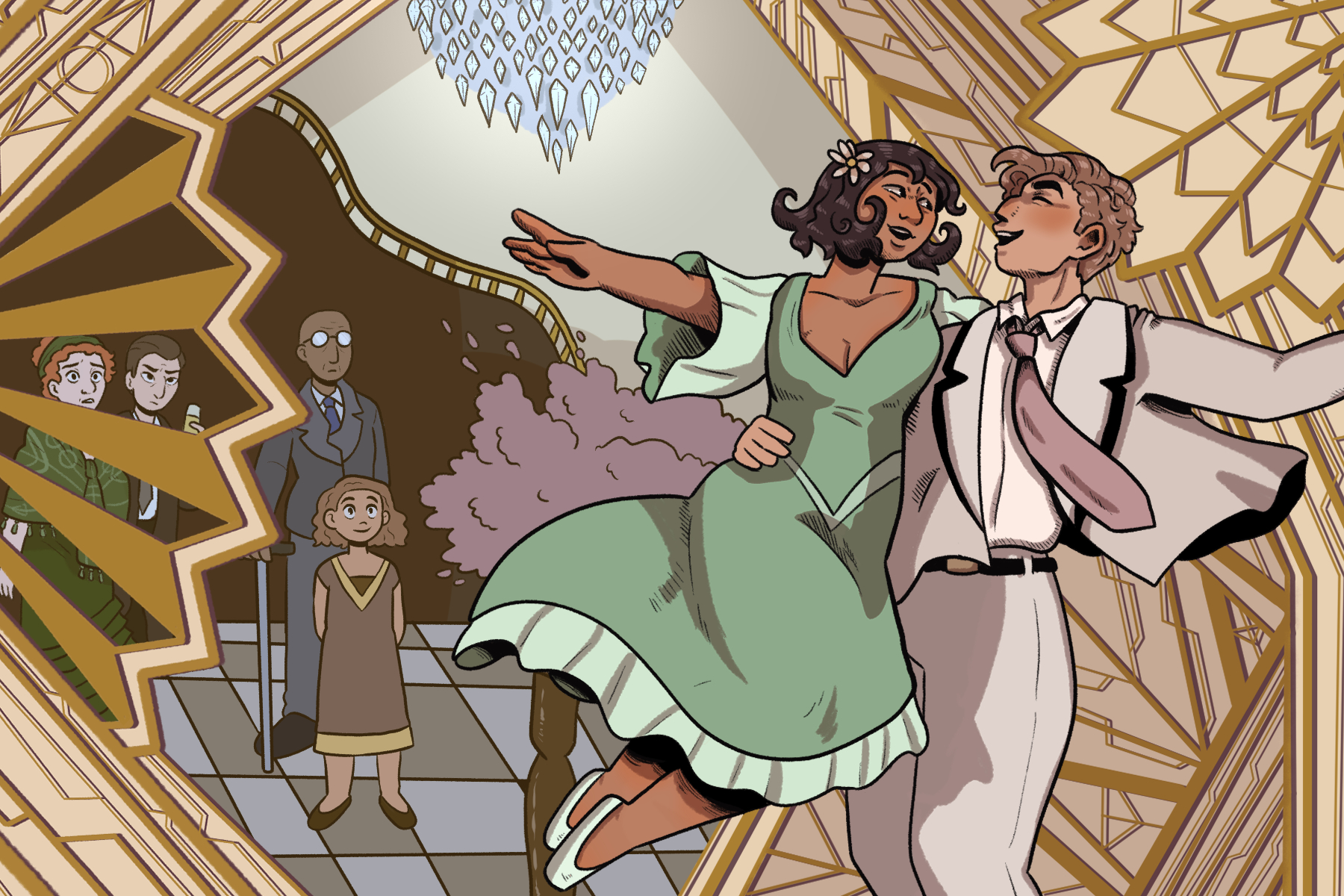Nearly a century after its original publication and a decade after the film adaptation, F. Scott Fitzgerald’s “The Great Gatsby” is experiencing yet another resurgence in popular culture. At the Park Central Hotel in Midtown, Manhattan, the classic novel’s cast of characters transports audiences to the 1920s within an immersive experience of Jazz Age glamour.
The theatrical performance takes place in the hotel’s ballroom, turning a once-vacant venue into the swanky Gatsby Mansion where Nick, Daisy, Tom and Jay Gatsby himself embrace the shameless superficiality of the Roaring Twenties. Audiences participate in a live choose-your-own-adventure story with numerous possibilities for how the evening might play out. With the chance to interact one-on-one with iconic literary characters, observe the celebratory antics from afar or unwind at the bar with a Prohibition-era cocktail (or revisit the show to experiment with an alternate journey), the possibilities are practically endless. The show doesn’t necessarily follow the same linear progression as the novel, since multiple scenes are played out simultaneously to subgroups of the audience, both for the sake of time and originality. As the New York Theatre Guide notes, though, the experience is “truly both immersive and interactive,” with the opportunity to speak and act directly with the performers. And of course, to truly immerse yourself in the environment Fitzgerald originally crafted, adherence to a 1920s dress code is strongly encouraged.
This production is ingeniously apt for a narrative such as “The Great Gatsby,” where the titular character’s ultimate motive is to repeat the past, despite Nick’s cynical narrations. While it is physically impossible for anyone to time-hop back to Jazz Age New York, the allure to experience a reproduction of the era remains strong. Fitzgerald’s garish depiction of life in a thriving America is a staple of most literature courses and is lauded as one of the canonical “great American novels,” which makes it easy to understand why decades later, swarms of enthusiasts gladly pay for a glimpse into the world of their favorite story. Then again, life has changed so drastically since Jay Gatsby first charmed readers with his enigmatic persona and exclusive parties. What, then, is the driving force behind the sustained afterlives of a 20th-century novel such as “The Great Gatsby?”
On a pragmatic level, the 2021 copyright expiration of Fitzgerald’s original publication means that the classic story has entered the public domain and opened the door for creators to offer a reinterpretation. Awave of previously protected literature is released into the hands of the public every year. Competing publishing houses produce new print editions along with access to free digital copies, often followed by a buffet of Hollywood adaptations, all without the need to secure rights. Audiences are generally excited about the new possibilities, but the original owners of the work tend to be more wary. In the case of “The Great Gatsby,” Fitzgerald’s great-granddaughter and heir to his estate expressed concern regarding the preservation of the beloved novel’s reputation once the copyright expired.
There is a distinctly enduring appeal to Fitzgerald’s dazzling tale beyond its status in the public domain. Analyses of “The Great Gatsby” waste no time pointing out its connection to the never-ending chase for the elusive American dream, symbolized by the steadfast glow of the green light at the end of the dock. Readers of all generations engage in passionate debates on the subject, either believing that Gatsby represents the fruitful potential of an American capitalist spirit or that he depicts the inevitable disappointment that follows an overextension in ambition.
On one hand, Jay Gatsby built his life of luxury from humble beginnings, motivated by Daisy’s youthful rejection of him when he was just a poor soldier from a small town. From this meager foundation, Gatsby continued his upward mobility—although through morally objectionable means—to cultivate the personality of a mysterious millionaire with the hottest ticket in town. But on the other hand, Gatsby’s dogged pursuit of his unrequited love ultimately ends in rejection and lonely death. Fitzgerald’s subliminal message seems to be that money, and the power that comes with it, corrupts. Even with all of the grand parties thrown in Daisy’s honor, she chooses to stay with her husband. The fleeting fantasy that Gatsby stubbornly clings to is inseparably tied to his wealth. Despite the shiny exterior it produces, his riches prove to be his downfall as the tangled mess it creates earns him a fatal bullet. So, the most commonly identified theme of the novel is more layered than simply the pursuit of the American dream: it’s the nuanced struggle of balancing your expectations with reality, which makes the story relatable to any audience.
Another obvious charm of “The Great Gatsby” is its unabashed superficiality. Fitzgerald purposefully employs superficiality in his novel to make a point. The characters are intentionally shallow, the parties are intentionally gaudy and the money is intentionally flaunted. The New York Theatre Guide unsurprisingly identifies this material flashiness as the immersive experience’s greatest attraction, noting that audiences want to “get swept up in a bygone era at its most lavish, liquored, and loose-limbed.” Like Gatsby, most people would rather fantasize about what could’ve been and perpetually celebrate indulgence rather than face the monotony of the real world. Modern audiences can relate to this, and a quick “how to romanticize your life” search will validate this sentiment with a laundry list of trendy recommendations to spruce up your ordinary existence with splashes of glamour, which Gatsby would certainly approve of.
None of this means that “The Great Gatsby” is a flawless piece of American cultural history. There are tons of problematic moments in the novel—Tom Buchanan physically assaulting his mistress, the aristocratic social elite recklessly partying while lives are ruined, etc.—which is why it is imperative to employ critical thinking when reading any “classic” on a Literature 101 syllabus. However, there is some unique quality of “The Great Gatsby” that lends itself to reinterpretations and recognition in an already media-saturated 21st century, as evidenced by the new immersive Gatsby experience. Perhaps director Alexander Wright’s motto for the show says it best: “Come for the party. Stay for the social tragedy.”
















